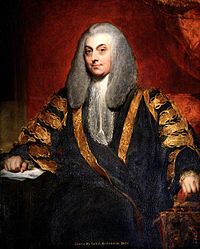John Freeman-Mitford, 1st Baron Redesdale, PC, KC, FRS (18 August 1748 – 16 January 1830), known as Sir John Mitford between 1793 and 1802, was an English lawyer and politician. He was Speaker of the House of Commons between 1801 and 1802 and Lord Chancellor of Ireland between 1802 and 1806.
The Lord Redesdale | |
|---|---|
 Sir John Mitford by Sir Thomas Lawrence | |
| Speaker of the House of Commons of the United Kingdom | |
| In office 11 February 1801 – 9 February 1802 | |
| Monarch | George III |
| Preceded by | Henry Addington |
| Succeeded by | Charles Abbot |
| Lord High Chancellor of Ireland | |
| In office 1802–1806 | |
| Monarch | George III |
| Prime Minister | |
| Preceded by | The Earl of Clare |
| Succeeded by | George Ponsonby |
| Personal details | |
| Born | John Mitford 18 August 1748 London, England |
| Died | 16 January 1830 (aged 81) Batsford Park, Gloucestershire, England |
| Spouse |
Lady Frances Perceval
(m. 1803; died 1817) |
Background edit
Born in London, Mitford was the younger son of John Mitford (d. 1761) of Exbury, Hampshire,[1] [2] and Philadelphia, daughter of Willey Reveley of Newton Underwood, Northumberland.[2] The historian William Mitford was his elder brother. He was educated at Cheam School and studied law at the Inner Temple from 1772, being called to the bar in 1777.[3]
Career edit
Having become a barrister of the Inner Temple in 1777,[2] Mitford wrote A Treatise on the Pleadings in Suits in the Court of Chancery by English Bill, a work reprinted several times in England, Ireland, and America.[4] He was made a King's Counsel in 1789.[5]
In 1788, he became Member of Parliament for the borough of Bere Alston in Devon,[1][6] and in 1791 he successfully introduced a bill for the relief of Roman Catholics, despite being himself a committed Anglican.[4] In 1793 he succeeded Sir John Scott as Solicitor-General for England[7] (receiving the customary knighthood at the same time), becoming Attorney General six years later,[1] when he was returned to parliament as member for East Looe in Cornwall.[1][8]
In 1794, he was elected a Fellow of the Royal Society.[9]
In February 1801, Mitford was chosen Speaker of the House of Commons[1] and sworn of the Privy Council.[10] Exactly a year later, he was appointed Lord Chancellor of Ireland[11] and raised to the peerage as Baron Redesdale, of Redesdale in the County of Northumberland.[11] Being an outspoken opponent of Catholic Emancipation, Redesdale was unpopular in Ireland. He had little support from his own colleagues: he was the subject of scurrilous attacks by "Juverna", who was later discovered to be a senior judge, Robert Johnson, who was convicted of seditious libel and forced to resign from the Bench as a result. In February 1806, Redesdale was dismissed on the formation of the Ministry of All the Talents.[4]
Although Lord Redesdale declined to return to official life, he was an active member of the House of Lords on its political and its judicial sides. In 1813, he secured the passing of acts for the relief of insolvent debtors, and became an opponent of the repeal of the Test and Corporation Acts and other popular measures of reform.[4]
Family edit
Lord Redesdale married Lady Frances Perceval, daughter of the 2nd Earl of Egmont, an Anglo-Irish peer, and sister of Prime Minister Spencer Perceval, in 1803.[1] He took the additional name of Freeman in 1809 by royal licence on succeeding to the estates of his relative Thomas Edwards-Freeman (the heir of a previous Lord Chancellor of Ireland, Richard Freeman).[12] Lady Redesdale died in August 1817.[1] Lord Redesdale survived her by thirteen years and died at Batsford Park, near Moreton-in-the-Marsh, Gloucestershire,[2] in January 1830, aged 81. He was succeeded in the barony by his only son, John, who was created Earl of Redesdale in 1877.[1]
Arms edit
|
References edit
- ^ a b c d e f g h Mosley, Charles, ed. (2003). Burke's Peerage, Baronetage & Knighthood (107 ed.). Burke's Peerage & Gentry. p. 3305. ISBN 0-9711966-2-1.
- ^ a b c d royalsociety.org Freeman-Mitford; John (1748–1830); 1st Baron Redesdale
- ^ "MITFORD, John (1748-1830), of Lincoln's Inn, London". History of Parliament Online. Retrieved 29 April 2016.
- ^ a b c d Greer, D. S. (2004). "Mitford, John Freeman-, first Baron Redesdale (1748–1830)". Oxford Dictionary of National Biography. Oxford Dictionary of National Biography (online ed.). Oxford University Press. doi:10.1093/ref:odnb/18857. Retrieved 20 March 2013. (Subscription or UK public library membership required.)
- ^ "No. 13115". The London Gazette. 18 July 1789. p. 501.
- ^ "leighrayment.com House of Commons: Bedford to Berwick upon Tweed". Archived from the original on 15 October 2018. Retrieved 5 November 2009.
{{cite web}}: CS1 maint: unfit URL (link) - ^ "No. 13502". The London Gazette. 12 February 1793. p. 127.
- ^ "leighrayment.com House of Commons: Ealing to Elgin". Archived from the original on 29 October 2013. Retrieved 5 November 2009.
{{cite web}}: CS1 maint: unfit URL (link) - ^ "Fellows Details". Royal Society. Retrieved 29 April 2016.
- ^ "No. 15338". The London Gazette. 17 February 1801. p. 201.
- ^ a b "No. 15452". The London Gazette. 9 February 1802. p. 140.
- ^ "No. 16224". The London Gazette. 28 January 1809. p. 131.
- ^ Anon (n.d.). "Redesdale, Baron (UK, 1902)". Cracroft's Peerage. Retrieved 2 September 2018.
- This article incorporates text from a publication now in the public domain: Chisholm, Hugh, ed. (1911). "Redesdale, John Freeman-Mitford, Baron". Encyclopædia Britannica. Vol. 22 (11th ed.). Cambridge University Press. p. 968.
External links edit
- Media related to John Freeman-Mitford, 1st Baron Redesdale at Wikimedia Commons